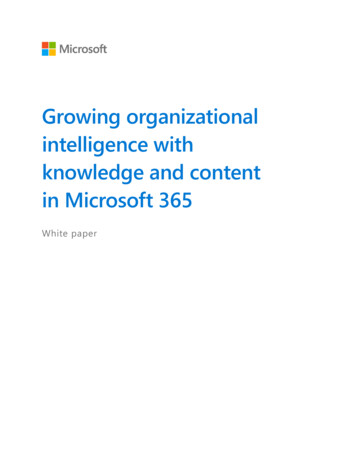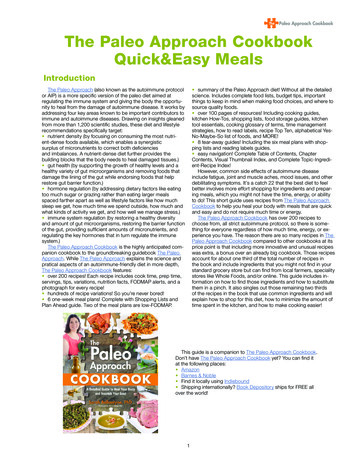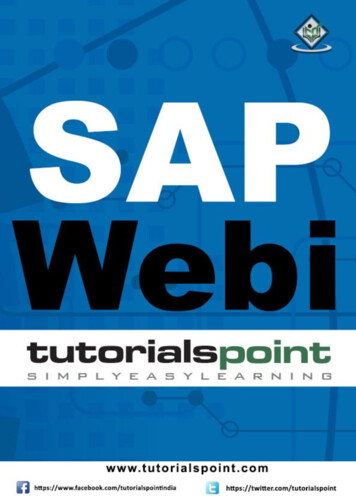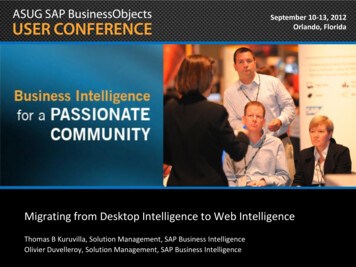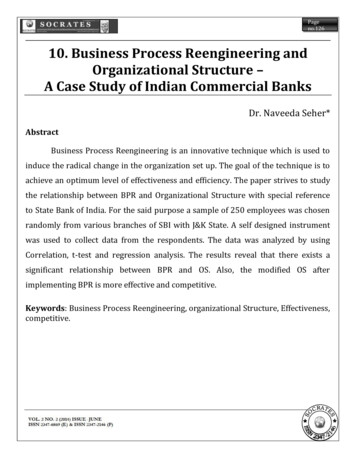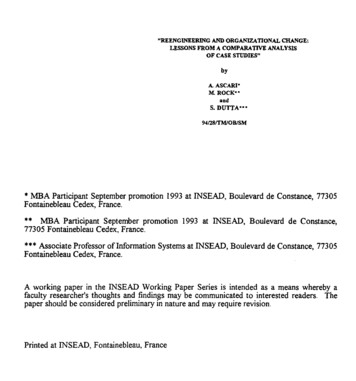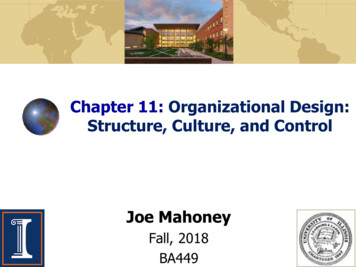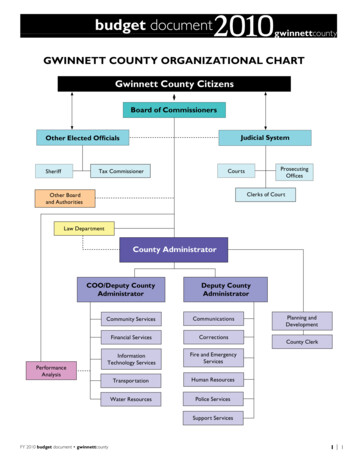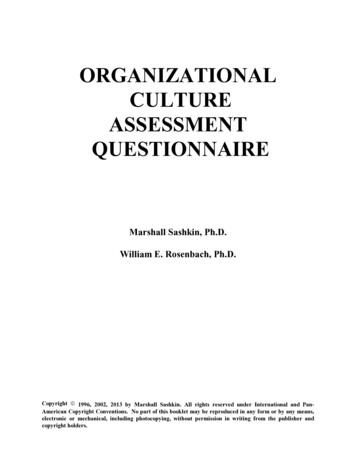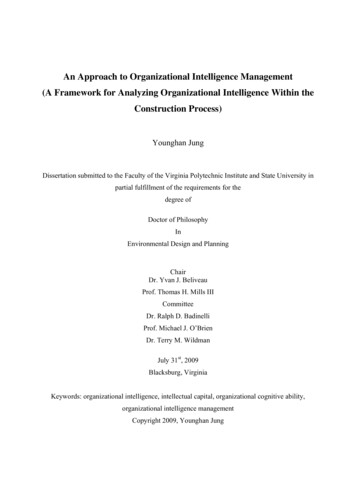
Transcription
An Approach to Organizational Intelligence Management(A Framework for Analyzing Organizational Intelligence Within theConstruction Process)Younghan JungDissertation submitted to the Faculty of the Virginia Polytechnic Institute and State University inpartial fulfillment of the requirements for thedegree ofDoctor of PhilosophyInEnvironmental Design and PlanningChairDr. Yvan J. BeliveauProf. Thomas H. Mills IIICommitteeDr. Ralph D. BadinelliProf. Michael J. O’BrienDr. Terry M. WildmanJuly 31st, 2009Blacksburg, VirginiaKeywords: organizational intelligence, intellectual capital, organizational cognitive ability,organizational intelligence managementCopyright 2009, Younghan Jung
An Approach to Organizational Intelligence Management(A Framework for Analyzing Organizational Intelligence Within theConstruction Process)Younghan JungABSTRACTThe construction industry is inherently multidisciplinary and has adopted manyintellectual and technical business improvements from other industries in an effort to optimizeproductivity. In construction, management inactivity is the root cause of 30% of non-productivetime. This has created an opportunity and need for standardized and structured repeatableprocedures for new managerial strategies.A theoretical framework for Organizational Intelligence (OI), which encompasses theprocedural ability of an organization to efficiently process, support, measure and reason throughmanagement issues, is proposed. The elements of organizational intelligence are divided intothree types of intellectual capital: Human Capital, Organizational Capital, and Relational Capital.The performance of an organizational activity depends on the quality of these capitals that areavailable within an organization. An organization's Human Capital (HC) is the human resourceswithin the organization that can be deployed to acquire and apply its knowledge to perform,respond, or control designated work with available organizational assets. Organizational Capital(OC) refers to the assets available to the organization to support the performance oforganizational activities Relational Capital (RC), which combines human capital andorganizational capital to perform, is needed specific organizational activities.In addition, the research uses human cognitive abilities as the basis of a fundamentalstructure from which to form new organizational cognitive abilities that are capable of presentingmanagement processes as critical value creations. Organizational cognitive ability is suggested todefine appropriate organizational resources in order to integrate and determine a rationalselection of applicable technologies and improvements. This ability can develop knowledge withinterconnected variables, namely intellectual capital, managerial process, and performance, all ofwhich support organizational intelligence.
From the theoretical framework for OI, a prototype (Intelligibility Learning Model), whichdetermines the role of relationships in an organization's operation and use of resources, isformulated. A case based research then applies the prototype to a managerial process in theconstruction industry. The case research demonstrates that the Intelligibility Learning Model(ILM) could be use effectively by industry decision makers to improve performance oforganizational activities. The identification and application of a theoretical frameworkconstitutes the foundation of a new managerial theory, Organizational Intelligence Management.It thus provides a fundamental foundation that explains how the construction processes,knowledge, skills, and resources used for managerial activities function. This theory contributesand establishes a better understanding of management, from organizational resources through tofinal production.iii
DEDICATIONTO MY FATHER, DONG-SIK JUNG, IN HEAVENMAY HIS SOUL REST IN PEACE!!Intelligence is such a word: we use it so often that we have come to believe in its existence,as a genuine tangible, measurable entity, rather than as a convenient way of labeling somephenomena that may (but may well not) exist.(Howard Gardner, 1983)iv
ACKNOWLEDGEMENTSI would like to express my deepest appreciation to all of committee members, especially myadvisor, Prof. Thom Mills, without whom this new theory, Organizational IntelligenceManagement would never have seen the light of day. He has provided both the guidance andfinancial support that I needed to finish my Ph.D. It has been a pleasure to work with him.I would also like to thank Dr. Yvan Beliveau, my co-advisor. He has wisely guided me andshared his extensive knowledge to help me in the logical development of this research.Special appreciation goes to Dr. Ralph Badinelli, who has generously contributed his time andattention to this intellectual endeavor. His critical reviews have helped the new theory ofOrganizational Intelligence Management to become a valuable basis for further development.I would also like to thank my committee members, Professor Michael O’Brien, and Dr. TerryWildman, for their guidance and contributions to my research. All my committee members haveencouraged me throughout my studies and their dedication and integrity has served as the modelfor the development of my academic maturity. I have learned many lessons from them, bothinside and outside the classroom, that will serve as a firm foundation for my future academic life.Thanks are also due to the construction professionals in the three companies that allowed me tocollect data through interviews and pilot studies: Nan Inc., Weston Solutions Inc. and ParsonsBrinkerhoff Korea.I would like to express the huge debt I owe to my family: my mother, Hyunsoon Lee, my wife,Eunjung Chun, , my son, Seungbae Richard Jung, my daughter, Lauren Yulim Jung, my brother,JaeHak Jung, my sister-in-law, InSun Lee, and all my family members. Without their love,support and perseverance, this endeavor would not have been possible.v
Special appreciation goes to my parents-in-law, UiKoo Chun and Jungha Cha, for their trust andsupport during this long journey.My deepest thanks go to my deceased father, DongSik Jung, who unfortunately did not live tosee the completion of one of his dearest dreams, this Ph.D. I will always miss his love andencouragement and will lead my rest of life guided by his great wisdom.Thanks also go to my friends and colleagues from all over the world for their support andencouragement throughout this lengthy process. Research is a team effort both inside and outsidethe university, and I appreciate all your contributions.Finally, I would like to repeat my special thanks to my wife, Eunjung Chun. She has providedendless love and support to me in spite of her illness. Without her, none of this would have beenpossible.vi
TABLE OF CONTENTSABSTRACT . iiDEDICATION. ivACKNOWLEDGEMENTS .vTABLE OF CONTENTS . viiLIST OF FIGURES . xiiLIST OF TABLES . xivCHAPTER 1: RESEARCH STATEMENT .11.1. Background .41.2. Relevance of Organizational Intelligence in Construction.51.3. Problem Statement.61.4. Research Objectives .101.5. Research Contribution .111.6. Justification .121.7. Hypotheses .131.8. Research Methodology .141.9. Scope and Limitation of Research .151.10. Dissertation Organization .18CHAPTER 2: LITERATURE REVIEW.202.1. What is ‘Intelligence’? .212.2. Human Intelligence Quotient (IQ) .222.3. Human Cognitive Abilities .27vii
2.4. The Linkage between Human Cognitive Abilities and IQ Tests .302.5. Machine Intelligence .372.6. Business Intelligence .382.7. The Evaluation Components for Human, Machine and Business Intelligence .402.8. Intellectual Capital.42CHAPTER 3: DEVELOPMENT OF ORGANIZATIONAL INTELLIGENCE .453.1. Conceptualization of Organization Intelligence.453.1.1. Definitions .453.2. Cognitive Ability Perspective - Emulation .473.3. Knowledge Creation - Categorization.523.3.1. Human Capital .563.3.2. Organizational Capital .563.3.3. Relational Capital .573.4. Organizational Activity – Analysis .583.5. Performance .603.6. Aspects of OIM with Various Factors from Intellectual Capital .61CHAPTER 4: A FRAMEWORK OF LEARNING MODEL PROTOTYPE .654.1. Organizational Intelligence Framework .654.2. Intelligibility Learning Model (ILM) Prototype .70viii
4.2.1. Procedural Analysis Perspective .734.2.2. Ability Intensive Perpective .734.2.3. Interdependence Perspective .764.2.4. Capital Transformation Perspective .774.2.5. Performance Attribute Perspective .784.2.6. Performance Factors Perspective .794.3. Achieving OIM with the ILM Prototype .79CHAPTER 5: THE APPLICATION OF INTELLIGIBILITY LEARNING MODELWITHIN THE CONSTRUCTION PROCESS .865.1. Case Based Studies – Construction Management Procedure .885.1.1. Methodology .885.2. Project Management Operation – Submittal Process .915.2.1. Procedural Perpective .955.2.2. Interdependence Perspective .1045.2.3. Capital Transformation Perspective .1065.2.4. Performance Factors Perspective .1075.2.5. Ability Intensive Perspective .1085.2.6. Performance Attribute Perspective .112CHAPTER 6: ORGANIZATIONAL INTELLIGENCE MANAGEMENT WITHINTELLIGIBILITY LEARNING MODEL.1136.1. A Comparison of Different Systems .113ix p
organizational capital to perform, is needed specific organizational activities. In addition, the research uses human cognitive abilities as the basis of a fundamental structure from which to form new organizational cognitive abilities that are capable of presenting management processes as critical value creations. Organizational cognitive ability is suggested to define appropriate .

